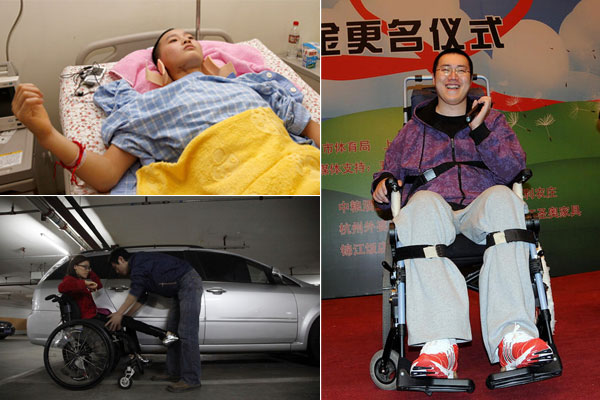Society
Sang Lan seeks her day in US court
By Hu Yongqi (China Daily)
Updated: 2011-06-16 08:39
 |
Large Medium Small |
|
|
Law professors said her case shows how vulnerable athletes are when they are badly injured or disabled. What matters more in this case, they said, is the difficulty of winning compensation due to litigation time limits, particularly overseas, and flaws in China's system to guarantee a secure life for retired athletes who were badly injured.
China has about 50,000 active registered athletes, China Central Television reported in May. More than 10,000 retire each year, CCTV said, and more than 70 percent of them have been injured or disabled. Thousands are struggling with medical care and a good life.
Jin Shan, director of the Sports Culture Research Center at the Beijing Academy of Social Sciences, said governmental subsidies, commercial insurance and charity funds should work together to meet financial needs of injured and disabled athletes.
In China's transition to a market economy, Jin said, commercial insurance should play a bigger role in providing subsidies to support injured athletes.
"If Sang Lan was insured before going to the Goodwill Games, the insurance dispute would never take place," said Yan Xufeng, professor of sports law at Beijing Sport University and a member of the Chinese Society of Sports Law.
Yan said sports insurance is supposed to cover unexpected injuries of Chinese athletes and sports games hosted in China. "Though yet to be improved, China's sports insurance has made much progress for the last decade."
During the "two sessions" of 1995, 11 members of the Chinese People's Political Consultative Conference proposed that disability and injury insurance be provided for elite athletes. The next year, Albert Hung Chao Hong, president of the South China Sports Association in Hong Kong, donated 12 million yuan ($1.84 million) to the China Sports Foundation as a special insurance fund for athletes.
In 1997, the personnel and finance departments of the General Administration of Sport of China (GASC) coordinated with funds for injured athletes to be distributed to the China Sports Foundation. A year later after Sang's accident, 1 million yuan was given to the foundation by the government.
Expanding program
Meanwhile, GASC issued regulations that defined 10 levels of disability that would be used to determine compensation. From 1998 to 2002, more than 1,400 elite registered athletes around the country received compensation, Yan said.
In September 2002, GASC began a pilot program of mutual insurance for injured and disabled athletes, although it did rule out surgical costs. Officials with the Sports Fund Management Center of GASC said the project charges much less than commercial insurance. Athletes each submit 40 to 100 yuan to build a fund, which should provide compensation to athletes a week to a month after injury, Yan said.
Athletes of national teams and provincial teams were included in the program originally. In 2004, athletes at city level and above also were insured, along with younger athletes in sports school who were training to compete in the Olympics and China's National Games.
Initially, compensation ranged upward from 3,000 yuan at the 10th damage level (meniscus damage, for example). As the number of covered athletes expanded and when a new level, 11, was added, the minimum compensation dropped to 1,000 yuan.
The maximum compensation for ordinary athletes was 200,000 yuan, but 600,000 yuan for Olympic champions if they were severely injured.
In 2004, China Sports Insurance Broker Co Ltd was registered, with fixed capital of 10 million yuan, to implement insurance policies for injured athletes.
About 25,000 athletes of 240 grassroots training units join the project each year, according to a report released by the Sports Fund Management Center last August.
Since 2002, more than 12,500 injured athletes have been compensated with a total of 33.31 million yuan. Ten families of athletes who died in contests were given 300,000 yuan each. Eight badly injured athletes were compensated with 200,000 yuan each.
Fewer than 10 sports insurance policies are available for injured athletes in China. About 80 percent of retired athletes with bad injuries have to struggle in hardship, according to Professor Yan.
"Compared with developed countries, especially the US and European Union, China's investment in sports insurance for professional athletes is not enough," Yan said.
Athletes also don't know enough about insurance, Yan said. He said most still think the government is responsible for insurance, as it was 30 years ago in the planned economy. In other countries, many athletes have their own insurance. For example, just-retired Brazilian soccer star Ronaldo insured his legs for $6 million.
Sang Lan's case reminds athletes who often go abroad to compete that they must know about local laws on compensation, lawyer Lu in Shanghai said.
"Sometimes sports officials shrink from claiming compensation for athletes because they think it's embarrassing to argue with hosts. Then athletes' justified rights to make claims are ignored," Lu said. "The mindset must be changed."
Chen Weihua in New York contributed to this report.
